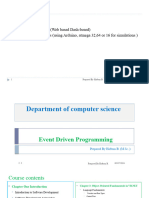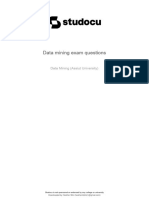100%(1)100% found this document useful (1 vote)
131 viewsModule 2 Multiple Choice Questions
This document contains 17 multiple choice questions that assess knowledge of key information technology and cybersecurity concepts. The questions cover topics such as information security and its goals of protecting information through confidentiality, integrity and availability. Additional topics include necessary security tools like policies, awareness and training; vulnerabilities and threats that can facilitate unauthorized access; and the three types of security controls - administrative, technical and physical.
Uploaded by
حياة أنثيCopyright
© © All Rights Reserved
Available Formats
Download as PDF, TXT or read online on Scribd
100%(1)100% found this document useful (1 vote)
131 viewsModule 2 Multiple Choice Questions
This document contains 17 multiple choice questions that assess knowledge of key information technology and cybersecurity concepts. The questions cover topics such as information security and its goals of protecting information through confidentiality, integrity and availability. Additional topics include necessary security tools like policies, awareness and training; vulnerabilities and threats that can facilitate unauthorized access; and the three types of security controls - administrative, technical and physical.
Uploaded by
حياة أنثيCopyright
© © All Rights Reserved
Available Formats
Download as PDF, TXT or read online on Scribd
You are on page 1/ 2
Multiple-choice questions for Module 2: IT and Cyber
1. Information security is about protecting information from unauthorized:
a) access
b) use
c) modification
d) all of the above
2. “A process of defining the security controls in order to protect the information assets”. This is
the definition of:
a) Information management
b) Information security management
c) Information security management protocol
d) Information technology management
3. The C.I.A. triangle includes:
a) Confidentiality
b) Intrusion
c) Confidentiality, intrusion and attacks
d) None of the above
4. Among the necessary tools for information security are:
a) Awareness
b) Training
c) Policy
d) All of the above
5. Among the most necessary tools for information security is:
a) Interconnectedness
b) Education
c) Communication
d) All of the above
6. Among the tools with little to no significance to information security is:
a) Policy
b) Education
c) Awareness
d) None of the above
7. Among the things that can facilitate unauthorized access to a computer by attackers are:
a) Software
b) Hardware
c) Procedural weakness of a safeguard
d) All of the above
8. The absence or weakness of a safeguard that could be exploited is called:
a) Threat
b) Vulnerability
c) Attack
d) Possibility
9. A threat is:
a) The potential danger to information or systems
b) A possibility that someone identifies a vulnerability
c) All of the above
d) None of the above
10. The entity that takes advantage of vulnerability is referred to as:
a) threat agent
b) vulnerability agent
c) risk agent
d) attacking agent
11. “The likelihood of a threat agent taking advantage of vulnerability and the corresponding
business impact” is called:
a) Vulnerability
b) Threat
c) Risk
d) Loss
12. In the context of information security, a synonym of risk would be:
a) Threat
b) Hacking
c) Security breach
d) None of the above
13. A cybersecurity safeguard could be:
a) Application
b) Software
c) All of the above
d) None of the above
14. The three types of security control are:
a) Administrative, bureaucratic and technical controls
b) Bureaucratic, policy and physical controls
c) Bureaucratic, logical and physical controls
d) Administrative, technical and physical controls
15. Physical controls, among other things, include:
a) Protecting the perimeter of the facility
b) Controlling individual access into the facility and different departments
c) All of the above
d) None of the above
16. The responsibilities for information security are divided between the following three groups:
a) Senior management, security officers, administrative staff
b) Senior management, functional management, operational management
c) Functional management, security management, administrative staff
d) Functional and operational managers and their staff
17. An information security project team would include:
a) System administrator but not a data custodian
b) Data custodian but not a system administrator or an end user
c) Risk assessment specialists but not security policy developers
d) Data custodian, system administrators, security policy developers
You might also like
- Higher Diploma in Network Technology & Cyber Security - ICBT Campus100% (1)Higher Diploma in Network Technology & Cyber Security - ICBT Campus3 pages
- Information Security Material For Exit Exam (IT)No ratings yetInformation Security Material For Exit Exam (IT)35 pages
- Empower Your Heart With Breakthrough Nitric Oxide Therapy - Tammy Hester100% (3)Empower Your Heart With Breakthrough Nitric Oxide Therapy - Tammy Hester20 pages
- Innovations in Portland Cement Manufacturing80% (5)Innovations in Portland Cement Manufacturing1,283 pages
- TOP NETWORKING Multiple Choice Questions and AnswersNo ratings yetTOP NETWORKING Multiple Choice Questions and Answers25 pages
- Chapter 2 Fundamentals of Information Systems Security100% (2)Chapter 2 Fundamentals of Information Systems Security50 pages
- DH-INT1472-CLC-Chapter 1 - Introduction to information securityNo ratings yetDH-INT1472-CLC-Chapter 1 - Introduction to information security55 pages
- Internet Security: Multiple Choice Question & Answers100% (1)Internet Security: Multiple Choice Question & Answers34 pages
- Haramaya University: Department of Information SystemsNo ratings yetHaramaya University: Department of Information Systems34 pages
- FINAL Information Security Questions and Some Answers Webinar PDFNo ratings yetFINAL Information Security Questions and Some Answers Webinar PDF25 pages
- Importance of Cyber Security IJERTCONV8IS05036No ratings yetImportance of Cyber Security IJERTCONV8IS050363 pages
- Technological Drivers For Cloud ComputingNo ratings yetTechnological Drivers For Cloud Computing23 pages
- Lec 2 (Introduction To Data and Network Security)No ratings yetLec 2 (Introduction To Data and Network Security)12 pages
- Chapter 5. Security at Different LayersNo ratings yetChapter 5. Security at Different Layers49 pages
- W1-2 Module 1 Introduction To Cyber Security100% (2)W1-2 Module 1 Introduction To Cyber Security19 pages
- Ambo University Woliso Campus, Technology and Informatics School Department of Computer ScienceNo ratings yetAmbo University Woliso Campus, Technology and Informatics School Department of Computer Science27 pages
- Chapter 10 - Computer Security and Risks PDFNo ratings yetChapter 10 - Computer Security and Risks PDF15 pages
- Chapter 1: Maintenance, Upgrade and RepairNo ratings yetChapter 1: Maintenance, Upgrade and Repair35 pages
- Chap1. Introduction Number Theory and Basic CryptographyNo ratings yetChap1. Introduction Number Theory and Basic Cryptography148 pages
- 9.1.1.6 Lab - Encrypting and Decrypting Data Using OpenSSL - OK PDFNo ratings yet9.1.1.6 Lab - Encrypting and Decrypting Data Using OpenSSL - OK PDF3 pages
- 18CSC364J - Information Security MCQ UNIT 4No ratings yet18CSC364J - Information Security MCQ UNIT 45 pages
- Wireless Energy Meter Reading Using RF Technology100% (1)Wireless Energy Meter Reading Using RF Technology26 pages
- 8630 Miele Built in Brochure 2013 Pureline 2No ratings yet8630 Miele Built in Brochure 2013 Pureline 228 pages
- Module Title: IT Management Module Code: KC704 Individual Essay (3000 Words)No ratings yetModule Title: IT Management Module Code: KC704 Individual Essay (3000 Words)2 pages
- WEF Facilitating Global Interoperability Cyber Regulations 2023No ratings yetWEF Facilitating Global Interoperability Cyber Regulations 202312 pages
- Clinical Handbook of Couple Therapy Third Edition Alan S. Gurman All Chapters Instant Download100% (1)Clinical Handbook of Couple Therapy Third Edition Alan S. Gurman All Chapters Instant Download80 pages
- Pan Pearl River Delta Physics Olympiad 2014: V 10 M/s VNo ratings yetPan Pearl River Delta Physics Olympiad 2014: V 10 M/s V10 pages
- Revised Blooms Taxonomy Process Verbs Assessments and Questioning StrategiesNo ratings yetRevised Blooms Taxonomy Process Verbs Assessments and Questioning Strategies2 pages
- Mobile Email Database of Doctors SampleNo ratings yetMobile Email Database of Doctors Sample11 pages
- Lecture 3 - Variables Constants and Data TypesNo ratings yetLecture 3 - Variables Constants and Data Types34 pages

























































































